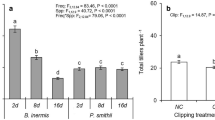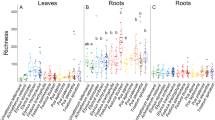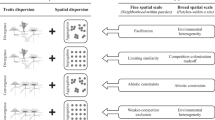Abstract
HERBACEOUS perennials with determinate shoots commonly produce new aerial stems by rhizomes, stolons or adventitious root buds1–5. The usual result is a more or less dense clone. Preliminary field studies were made of tightly packed clones of goldenrods (Solidago spp., Compositae), common in late herbaceous stages of succession in the eastern USA. These studies suggested orderly geometric patterns of rhizome production.
This is a preview of subscription content, access via your institution
Access options
Subscribe to this journal
Receive 51 print issues and online access
$199.00 per year
only $3.90 per issue
Buy this article
- Purchase on Springer Link
- Instant access to full article PDF
Prices may be subject to local taxes which are calculated during checkout
Similar content being viewed by others
References
Bell, A. D., J. Arnold Arbor., 55, 458–468 (1974).
Kershaw, K. A., J. Ecol., 46, 571–592 (1958).
Kershaw, K. A., J. Ecol., 47, 31–53 (1959).
McCormick, J., Hicks, V., Jordan, M., and Smith, A. P., Bull. N. J. Acad. Sci., 12, 49–50 (1967).
Phillips, M. E., J. Ecol., 41, 295–318 (1953).
Soil Survey of Delaware. County and Chester County, Pennsylvania (USDA Soil Conservation Commission, 1963).
Author information
Authors and Affiliations
Rights and permissions
About this article
Cite this article
SMITH, A., PALMER, J. Vegetative reproduction and close packing in a successional plant species. Nature 261, 232–233 (1976). https://doi.org/10.1038/261232a0
Received:
Accepted:
Issue Date:
DOI: https://doi.org/10.1038/261232a0
This article is cited by
-
The effect of branching angle on adaptive growth in patchy environments
Evolutionary Ecology (2017)
-
Do spatial patterns of clonal fragments and architectural responses to defoliation depend on the structural blue-print? An experimental test with two rhizomatous Cyperaceae
Evolutionary Ecology (2010)
-
Clonal extent, apical dominance and networking features in the phalanx angiosperm Zostera noltii Hornem.
Marine Biology (2007)
-
Stochastic simulation of clonal growth in the tall goldenrod, Solidago altissima
Oecologia (1991)
-
Fine-scale spatial distribution of leaves and shoots of two chalk grassland perennials
Vegetatio (1990)
Comments
By submitting a comment you agree to abide by our Terms and Community Guidelines. If you find something abusive or that does not comply with our terms or guidelines please flag it as inappropriate.



